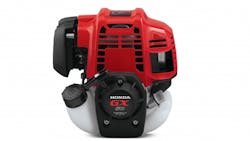Honda Engines Expands Mini-Four Stroke Engine Lineup with the GX50
At the 2019 ARA Show, Honda Engines introduced the all-new, high-output Honda GX50, expanding the company’s Mini-Four Stroke lineup with a more powerful model. Joining the Honda GX25 and Honda GX35, the new GX50 incorporates a higher displacement, making it a match for demanding rental, industrial, construction and professional landscape applications. Available now, the versatile Honda GX50 brings its light weight, compact design, and fuel efficiency to power products ranging from brush cutters to rammers and vibrators to concrete screeds, post drivers and winches.
More than 20 years ago, Honda introduced its GX22 and GX31 Mini-Four Stroke engines, models that would, for the first time, be used to power handheld power equipment. In a market previously dominated by two-stroke engines, Honda developed the industry’s first 360-degree inclinable four-stroke models, and the company’s successful product development continued with the 2002 launch of the Honda GX25 and GX35 Mini-Four Strokes. These engines, with a higher output and more lightweight than the GX22 and GX31, incorporated an advanced design including a cross-flow combustion chamber, providing a wide, smooth range of torque unique to four-stroke technology. Manufacturing techniques have reduced the number of moving parts, and many of these techniques have resulted in reduced engine weight and smoother operation for the end user.
In the mini-four stroke space, customers requiring higher output engines for different types of handheld equipment requested a two-horsepower class, four-stroke engine with superior fuel efficiency and higher work efficiency, the company said. In 2019, Honda responds with the GX50, a four-stroke model with a power-to-weight ratio matched to leading two-stroke models. With valvetrain parts installed inside the oil chamber, low noise and low vibration, the Honda GX50 can power even more applications in the handheld market.
“Today’s all-new Honda GX50 is the next evolution in the mini-four stroke category, the first four-stroke engine in the two-horsepower class that is 360-degrees inclinable during operation and storage,” said Will Walton, vice president, Honda Power Equipment. “Excellent fuel efficiency, low emissions, high output and easy starting performance, combined with low noise and vibration, as well as a compact, lightweight design, place the Honda GX50 engine squarely into the demanding rental, industrial, construction and professional landscape space.”
Honda produced the compact and lightweight design of the Honda GX50, in part, by integrating the valvetrain chamber into the oil chamber. This in-oil timing belt, the smallest class in-oil timing belt, also is made of a highly durable material usually found in high rotational speed engines.
For ease in starting, Honda incorporated an automatic decompression mechanism into the design of the all-new GX50, serving to reduce the recoil pull load and thereby reducing the start-up load. The mechanism consists of a decompression weight and spring that depresses the exhaust valve side rocker arm. The weight attached to the cam pulley moves by centrifugal force, and when the recoil starter rope is pulled, the exhaust valve is opened slightly during the compression stroke by the decompressor and reduces engine compression. While the engine is running, if the engine RPM is above the control value, centrifugal force causes the weight to move and keep the exhaust valve closed during the compression stroke, and the exhaust valve operates normally. Overall, reducing the pressure inside the cylinder lessens the amount of effort required to pull the recoil starter. Finally, an inner protector between the muffler and the outer cover helps to reduce noise and produce quiet engine operation.
The Honda GX50 is available nationwide, and parts and service are widely available through the Honda National Dealer Network. For commercial and rental use, all models carry a one-year warranty, and for residential use, a two-year warranty applies.
About the Author
Michael Roth
Editor
Michael Roth has covered the equipment rental industry full time for RER since 1989 and has served as the magazine’s editor in chief since 1994. He has nearly 30 years experience as a professional journalist. Roth has visited hundreds of rental centers and industry manufacturers, written hundreds of feature stories for RER and thousands of news stories for the magazine and its electronic newsletter RER Reports. Roth has interviewed leading executives for most of the industry’s largest rental companies and manufacturers as well as hundreds of smaller independent companies. He has visited with and reported on rental companies and manufacturers in Europe, Central America and Asia as well as Mexico, Canada and the United States. Roth was co-founder of RER Reports, the industry’s first weekly newsletter, which began as a fax newsletter in 1996, and later became an online newsletter. Roth has spoken at conventions sponsored by the American Rental Association, Associated Equipment Distributors, California Rental Association and other industry events and has spoken before industry groups in several countries. He lives and works in Los Angeles when he’s not traveling to cover industry events.
